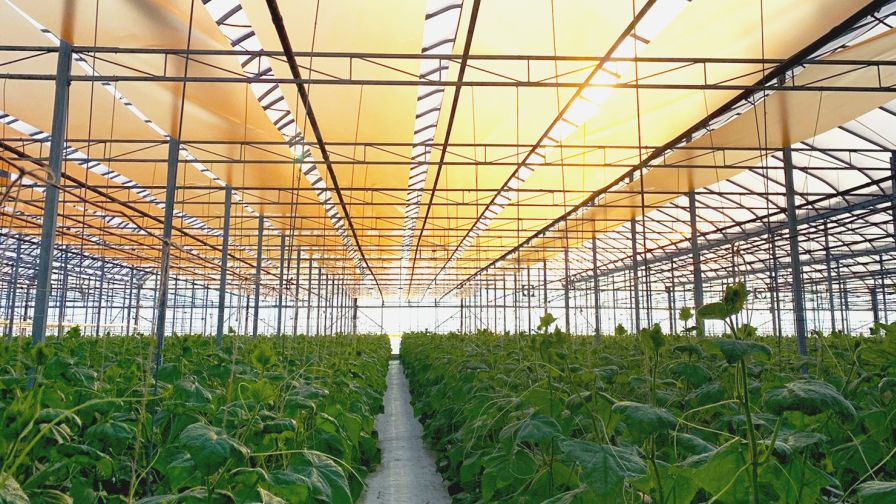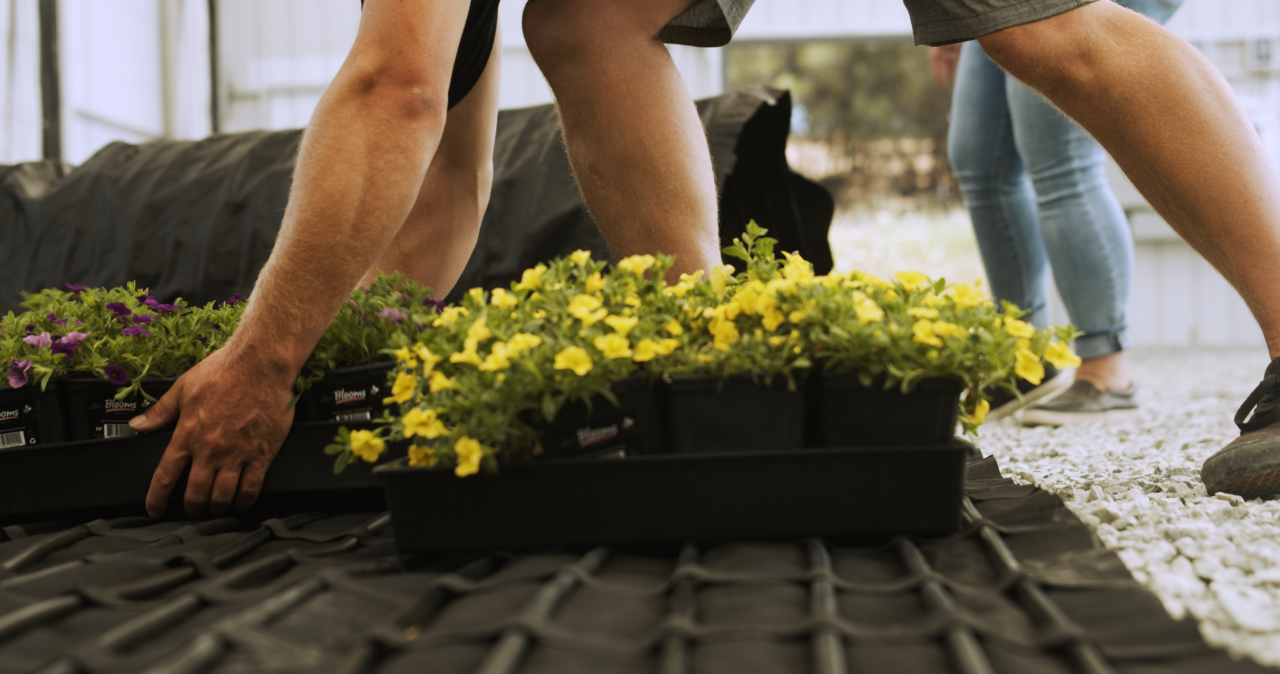Nanotechnology: Coming to a Greenhouse Near You

UbiGro-Inner 600 orange luminescent quantum dot films are installed over cucumbers in this greenhouse in Leamington, Canada. Photos: UbiQD, Inc.
Between nanotech, artificial intelligence (AI), and the never-ending onslaught of apps designed to help you make sense of data, it can seem like tech is taking over the world, even in the greenhouse.
However, some cool things are happening in the nano space, and they could provide a competitive edge for your operation. Here’s a look at some emerging uses for nanotech in the greenhouse.
While it may seem new, nanotech as a science has been around for a while. According to the National Nanotechnology Initiative (NNI), modern nanotechnology began in the early 1980s and includes “science, engineering, and technology conducted at the nanoscale, which is about 1 to 100 nanometers.” Nanometers are abbreviated as “nm.” To provide a reference, NNI explains that a sheet of newspaper is about 100,000 nm thick.
Benefits of Nanoparticles
Fertilizers, pest treatments, and micronutrient solutions are expensive, and no one wants to waste any. Targeting applications for better bioavailability and more efficient plant uptake is what agricultural nanoparticles are all about.
One of the growing uses is nanofertilizers. Nanofertilizers aren’t just small pieces of regular fertilizer. Think instead of a nano-sized delivery truck to increase the efficiency of nutrient absorption. While small, in the realm of 10-100nm, a nanoparticle is still hundreds of times larger than a calcium ion or other nutrient. Electrostatic charges attract these ions to the nanoparticle, in effect loading it up.
Dr. Landon Bunderson, Chief Science Officer at Aqua-Yield, explains that nanoparticles “leverage the already existing mechanism of endocytosis to deliver bigger payloads to the cell.” It’s a method plants have for bringing larger particles through the cell wall, particles that are too large to pass through the cell membrane by other methods. When nanofertilizer is passed through the cell wall, this supercharged nutrient-bearing particle is available to the plant.
Nanoparticles aren’t limited to fertilizer — they can be used to enhance the delivery of insecticides, fungicides, and other treatments. Root starters, calcium, potassium, whatever the material is, Bunderson says nanoparticles may be able to help.
Enhanced nutrient delivery and increased absorption rates create benefits, including larger root mass, lower fertilizer and additive use, higher yields, and quicker crop cycle times. Nanoparticles can be utilized in all growth phases, from aiding in germination and establishment to finishing, and they are cost-effective.
“Everybody has an absorption pain point,” says Bunderson, although growers don’t often frame it that way. Getting nutrients and treatments into the plant tissue is an absorption problem. With the ability to seamlessly integrate into current application systems, nanoparticle users are seeing great results.
Growers can mix nanoparticles with their existing fertigation systems. As results are observed, adjust application rates to reflect the new efficiencies.
Nanobubbles Help You Grow Healthier Plants
Nanobubbles are here, and they can do more than raise your dissolved oxygen. Nanobubbles increase and stabilize the oxygen available to plants in the rhizosphere, resulting in more robust root systems and healthier plants, but that’s not their only benefit. Increased oxygen in the root zone shifts the environment toward an aerobic situation and favors beneficial bacteria over harmful ones.
Davey Rock is the Moleaer Business Development Manager for the Midwest U.S. He says a common reason growers include nanobubbles in their system is for biofilm mitigation and reduction of line maintenance. Nanobubbles, due to their strong negative charge and hard, stable surface, are an efficient and safe way to minimize biofilm issues in your operation.
Rock explains that nanobubbles are also an oxidant, releasing a hydroxy radical when they pop. In one case study, Pythium levels were reduced by 81% vs. non-treated water at the same location.
Higher yields, faster crop cycle times, and fewer disease issues make nanobubbles worth looking into.
Nanofilms Enhance Existing Light
Our sun produces light in many wavelengths, but as growers know, not all are equally efficient for photosynthesis.
UbiGro is a company producing a flexible film that uses nanotech to alter incoming sunlight, absorbing a UV or blue photon and emitting an orange/red photon in its place. The process is called photoluminescence, and the film glows in the sunlight, preserving the brightness and intensity of the sun in the greenhouse instead of filtering or blocking it. Dr. Damon Hebert is the Director of Agriculture Research at UbiGro.
“We can do better than sunlight in terms of spectrum,” he says.
Using a technology called quantum dots, also found in other applications like high-end televisions, the film re-emits light in more efficient wavelengths and diffuses it, creating a more efficient environment for plants to grow.
The quantum dot film enhances existing light and increases efficiency but doesn’t make more of it. The film is a passive technology — nothing is plugged into the wall. About half of the customers also use artificial lighting, says Hebert, to increase day length or the overall amount of light available, known as Daily Light Integral (DLI).
“The bottom line is driving a yield increase,” Hebert says. “We’ve seen yield increases of +5% to +25% over a wide variety of crops, with payback times of less than two years for high-value veggies and one to two harvests for high-value medicinal crops.”
These films are designed for installation in existing structures, from low-tech hoop houses to large engineered greenhouses. They have been tested in a wide variety of crops worldwide, including cannabis, strawberries, lettuce, tomatoes, and microgreens. Nanotechnology can seem like a pie-in-the-sky tech for only the biggest growers, but that’s far from the truth. Nanofertilizers, nanobubbles, and nanofilms are scalable and useable by small and large growers. With the rising costs of inputs and energy, a little more efficiency is more than welcome.








